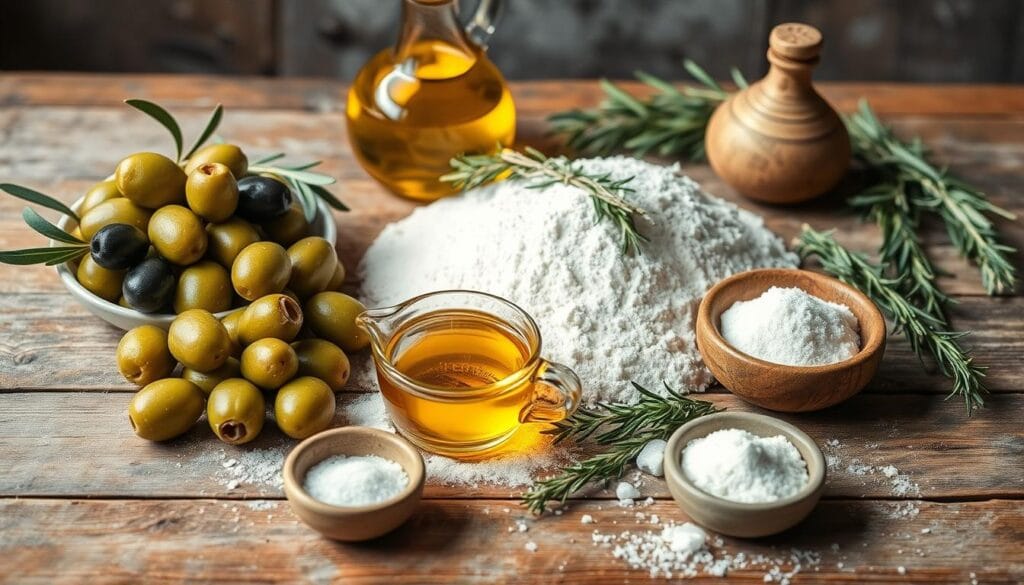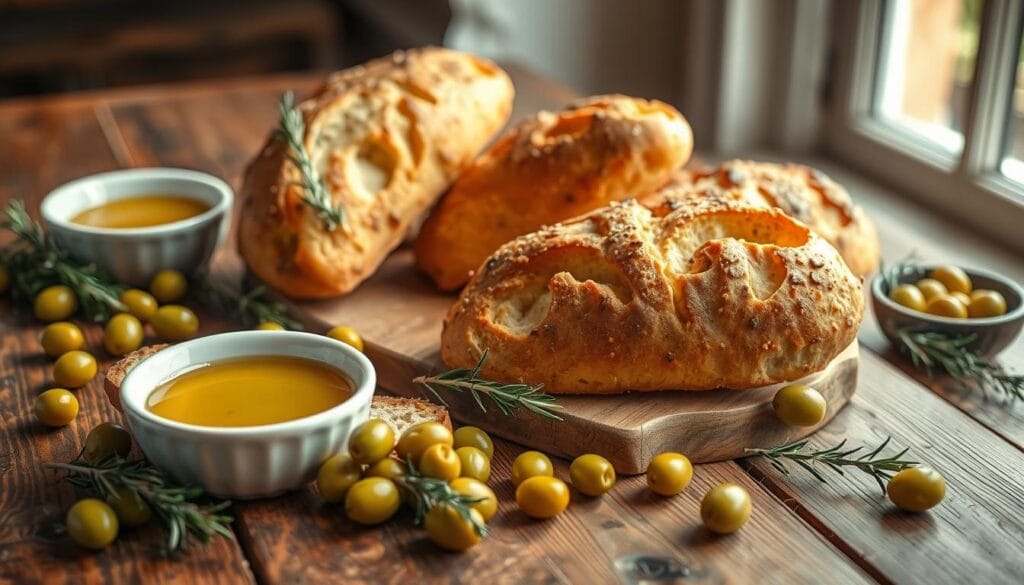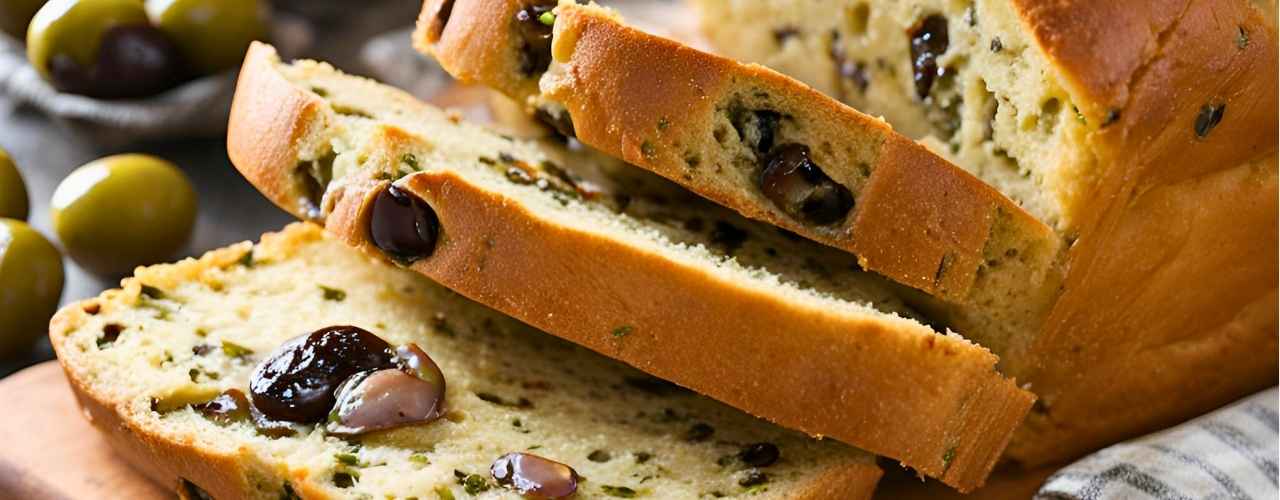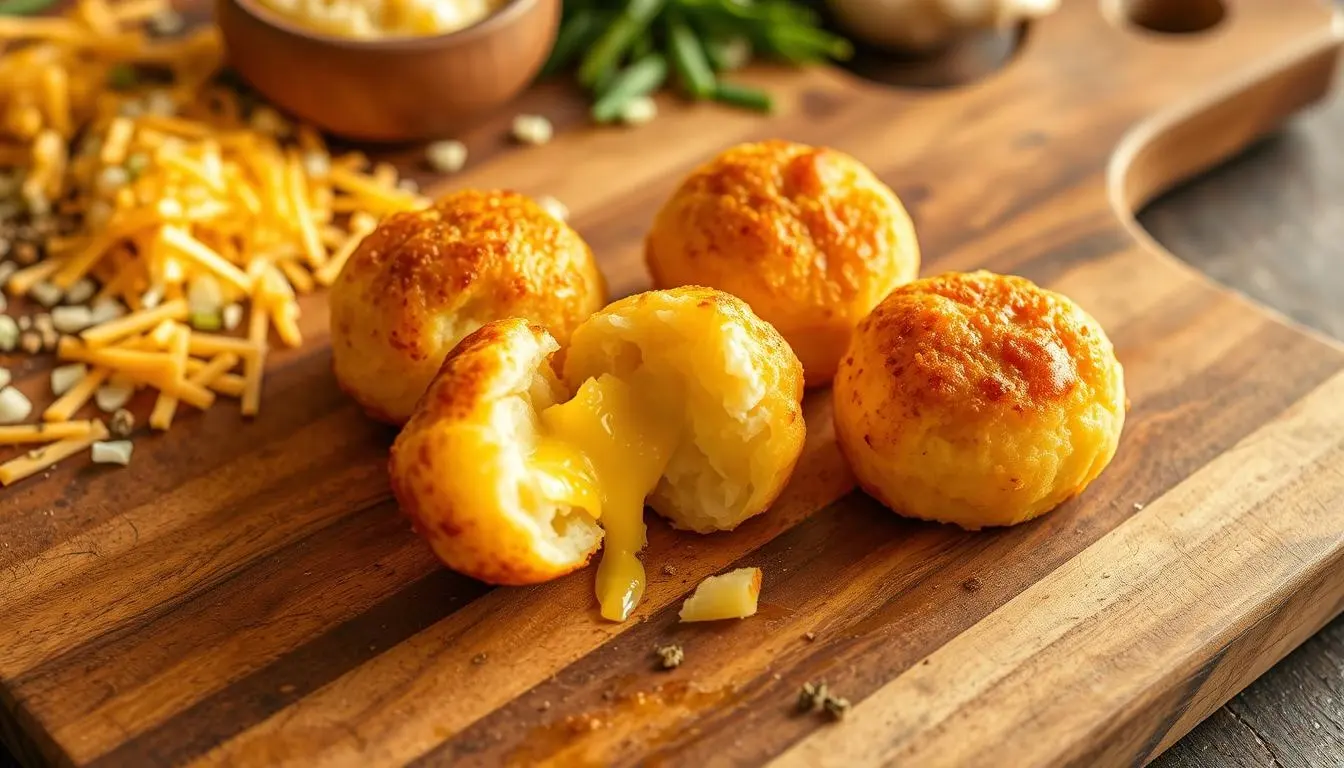Table of Contents
I still remember the first time I tried olive bread. It was love at first bite. The crispy crust, savory olives, and fresh aroma were irresistible. Since then, I’ve been perfecting my olive bread recipe.
If you want to learn how to make olive bread, you’re in the right place. We’ll explore the world of olive bread. You’ll learn the best recipe and how to make it.
Olive bread is a must-try for bread lovers. It has a golden crust and flavorful ingredients. Our recipe is easy to follow and requires just a few ingredients, like bread flour, yeast, and olives.
As we explore olive bread, you’ll learn its secrets. We’ll cover everything from the right water temperature to the best olives to use. So, if you’re ready to improve your baking skills, let’s start.
The Rich History of Olive Bread
Olive bread has a long history in the Mediterranean, where olives were key. The traditional recipe uses olive bread ingredients like bread flour, yeast, salt, and olives. It also includes warm water and a bit of olive oil.
In this area, rustic bread with olives was everywhere. Each village had its own special recipe and way of baking. Today, olive bread recipes have changed, adding things like cheese and herbs.
Traditional olive bread often includes Kalamata olives from Greece. These olives are famous for their strong taste and chewy texture. When making bread, start with 3 cups of water and add more as needed to form the dough.

To make a tasty rustic bread with olives, use top-notch olive bread ingredients and stick to a classic recipe. Olive bread is a great choice for anyone wanting to enjoy Mediterranean flavors.
Essential Ingredients for Perfect Olive Bread
To make perfect olive bread, you need the right ingredients. The olive bread recipe calls for just 7 ingredients. These include 3 and 1/4 cups of bread flour, 2 teaspoons of instant yeast, and 1 teaspoon of salt. You’ll also need 1 and 1/2 cups of warm water, 1 tablespoon of olive oil, 2 teaspoons of honey, and 1 cup of chopped kalamata olives. It’s important to choose the best ingredients and measure them accurately when learning how to make olive bread.
For a delicious olive bread recipe, use high-quality ingredients. Here’s what you’ll need:
- 3 and 1/4 cups of bread flour
- 2 teaspoons of instant yeast
- 1 teaspoon of salt
- 1 and 1/2 cups of warm water
- 1 tablespoon of olive oil
- 2 teaspoons of honey
- 1 cup of chopped kalamata olives
Using the right ingredients and following the olive bread recipe will give you a tasty loaf. With these ingredients, you can make a perfect

| Ingredient | Quantity |
|---|---|
| Bread Flour | 3 and 1/4 cups |
| Instant Yeast | 2 teaspoons |
| Salt | 1 teaspoon |
| Warm Water | 1 and 1/2 cups |
| Olive Oil | 1 tablespoon |
| Honey | 2 teaspoons |
| Chopped Kalamata Olives | 1 cup |
My Tried and Tested Olive Bread Recipe
Making a tasty rustic bread with olives is all about quality ingredients and trying new flavors. My go-to is olive and rosemary bread. It mixes the deep taste of olives with rosemary’s earthy notes.
You’ll need a few things to make this bread. These include bread flour, yeast, kosher salt, lukewarm water, and chopped olives. I prefer mixing green and black olives for a rich, salty taste.

You can also add extras like fresh herbs or grated cheese. Here are some ideas for different flavors:
- Adding diced sun-dried tomatoes for a juicy kick
- Using different olives, like Kalamata or Gaeta
- Adding chopped fresh rosemary or thyme for a fragrant taste
By following this recipe and trying out different flavors, you can make a delicious rustic bread with olives. It’s great for snacks, sandwiches, or with soups and stews.
Kitchen Tools and Equipment Needed
To make olive bread, you’ll need some basic kitchen tools. Having the right tools makes the process smoother and more efficient. You’ll need a mixing bowl, a measuring cup, and a Dutch oven. A Dutch oven is key for a crusty top and a soft inside.
Other important tools for olive bread include:
- A wooden spoon or dough whisk for mixing the dough
- A pastry cloth or lightly floured surface for kneading the dough
- A baking sheet or bread peel for transferring the dough to the oven
Having the right equipment can greatly impact your olive bread. For instance, a Dutch oven helps create a crispy crust. A pastry cloth prevents the dough from sticking during kneading.
It’s also crucial to understand the ingredients and their roles. By combining the right tools and ingredients, you can make a delicious olive bread. It’s perfect for any occasion.
| Tool/Equipment | Description |
|---|---|
| Mixing Bowl | Used for mixing the dough |
| Measuring Cup | Used for measuring the ingredients |
| Dutch Oven | Used for baking the bread |
Step-by-Step Mixing and Kneading Process
To make a tasty olive bread, follow a detailed mixing and kneading guide. This ensures your rustic bread with olives is full of flavor and texture. Start by mixing dry ingredients like bread flour, all-purpose flour, and salt in a big bowl.
Then, mix wet ingredients like water, olive oil, and active sourdough starter in another bowl. Slowly add the wet ingredients to the dry ones. Keep mixing until you get a shaggy dough. Be gentle, as too much kneading can make the bread dense.
After that, knead the dough for about 10 minutes. You can do this by hand or with a stand mixer. Kneading develops the gluten, making the bread chewy. Let the dough rest for 30 minutes to 1 hour to relax the gluten.
Now, add the olives to the dough. Fold them in gently so they’re spread out evenly. This adds a burst of flavor and texture to your olive bread.
- Combine dry ingredients in a large mixing bowl
- Mix wet ingredients in a separate bowl
- Gradually add wet ingredients to dry ingredients
- Knead the dough for 10 minutes
- Let the dough rest for 30 minutes to 1 hour
- Integrate the olives into the dough
By following these steps, you’ll make a delicious olive bread. It’s great with your favorite dishes.
Mastering the Proofing Stage
To make great olive bread, knowing about temperature and time is key. The best proofing temperature is about 78°F (25.5°C). The time needed can range from 4 to 24 hours, based on the recipe and the environment. Longer proofing times can make the bread taste deeper and have more bubbles on the crust.
Choosing the right flour is important when making olive bread. Bread flour with 12-14% protein is best, as it helps the bread keep its shape and texture. Adding olives, like Kalamata or Castelvetrano, can also change how long the dough needs to proof. This is because olives can soak up some of the water, affecting the dough’s moisture level.
Here are some tips for mastering the proofing stage: * Keep the temperature and humidity steady * Watch the dough and adjust the proofing time if needed * Using a sourdough starter can improve the bread’s taste and texture * Make sure the dough is away from drafts and direct sunlight
By following these tips and understanding the role of temperature and time, you can get the proofing stage right. This will help you make delicious olive bread with the right texture and flavor. Always use top-notch ingredients and try different olives and flavorings to find your favorite recipe.
| Proofing Time | Temperature | Humidity |
|---|---|---|
| 4-6 hours | 75-78°F (24-25.5°C) | 60-70% |
| 8-12 hours | 70-75°F (21-24°C) | 50-60% |
| 12-24 hours | 65-70°F (18-21°C) | 40-50% |
Baking Tips for the Perfect Crust
Getting the perfect crust on your olive bread is key. To achieve this, follow some important baking tips. For a rustic bread with olives, you want a crispy outside and a soft inside.
Start by preheating your oven to 425°F (218°C). This temperature helps get a golden-brown crust. Using a Dutch oven or combo cooker is also crucial. It creates a steamy environment, which is great for the crust.
Here are some additional baking tips to keep in mind:
- Bake your olive bread recipe at 425°F (218°C) for 35-40 minutes, or until the crust is golden brown and the internal temperature reaches 195°F (90°C).
- Use a thermometer to check the internal temperature of your bread.
- Don’t open the oven door too often, as this can release the steam and affect the crust.
By following these tips, you’ll get a perfect crust on your olive bread. Be patient and don’t rush the baking. With practice, you’ll make a delicious rustic bread with olives that will wow your loved ones.
| Baking Temperature | Baking Time | Internal Temperature |
|---|---|---|
| 425°F (218°C) | 35-40 minutes | 195°F (90°C) |
Flavor Variations and Add-ins
Making olive and rosemary bread is fun because you can try many things. You can add chopped kalamata olives or coarse salt for extra taste. This makes your bread special.
To make olive bread, start with a basic recipe. Then, add your favorite ingredients. Try fresh rosemary, garlic, or cheese. Use different olives, like green or black, for a new taste.
Herb Combinations
Rosemary and thyme go well with olives, adding depth to your bread. Mixing herbs, like rosemary and garlic, creates a unique taste. Here are some herb mixes to try:
- Rosemary and olive
- Thyme and garlic
- Parsley and cheese
Cheese Options
Cheese is a great addition to olive bread. You can use parmesan, feta, or cheddar. Mixing cheeses gives a special flavor.
Creating great olive bread is all about trying new things. Experiment with ingredients and don’t worry if it takes time. With practice, you’ll make delicious olive and rosemary bread.
Storage and Serving Suggestions
After baking your olive bread, it’s key to store it right to keep it fresh. Ingredients like olives and cheese can lose their flavor if not stored well. To keep your bread fresh, store it at room temperature for 2-3 days.
If you need to keep it longer, freezing is a good option. Cool the bread down, then wrap it in aluminum foil. Put it in a sealed plastic bag. To serve, reheat it in the oven at 450°F for 10-15 minutes, still wrapped in foil.
Here are some ways to enjoy your olive bread:
- Slice the bread and top it with your favorite spreads, like hummus or tapenade.
- Make sandwiches or paninis with turkey, cheese, or veggies.
- Toast the bread and drizzle with olive oil, salt, and pepper for a tasty snack.
By following these tips, you can enjoy your homemade olive_bread for longer. Try different toppings and spreads to find your favorite.
Conclusion: Enjoying Your Homemade Olive Bread
As we wrap up our guide to making olive bread, I hope you’re excited to try it out at home. It might seem hard at first, but with practice, you’ll make homemade olive bread that wows everyone.
Love the classic Mediterranean taste or want to try something new? There’s nothing like biting into a warm slice. Try it with olive oil and balsamic vinegar for dipping, or use it for tasty sandwiches. The choices are endless!
Keep improving your baking skills and have fun with it. Homemade bread is all about making it your own. So, get creative, become your own baker, and enjoy the tasty results of your olive bread adventures.
FAQ
What is the history of olive bread?
Olive bread comes from the Mediterranean. It was made with olives, flour, and water. Today, it has evolved with ingredients like cheese and herbs.
What are the essential ingredients for making perfect olive_bread?
You need flour, salt, yeast, and water for olive bread. Choosing the right ingredients and measuring them correctly is key.
What is your tried and tested olive_bread recipe?
My recipe includes a list of base ingredients, a guide for choosing olives, and optional add-ins. I’ll guide you through mixing, kneading, and shaping the dough.
What kitchen tools and equipment are needed to make olive_bread?
You’ll need a mixing bowl, a measuring cup, and a Dutch oven. I’ll explain how to use these tools effectively.
How do I master the proofing stage for olive_bread?
The proofing stage is crucial for the dough to rise and develop-flavor. I’ll share tips on temperature and time for this stage.
What are some tips for baking the perfect olive_bread crust?
For a perfect crust, I’ll give you temperature guidelines and steam techniques. I’ll also talk about using a Dutch oven for a crusty top and soft inside.
What flavor variations and add-ins can I use to enhance my olive_bread?
You can try different herb combinations and cheeses for unique flavors. I’ll offer tips on experimenting with ingredients and creating your own flavors.
How should I store and serve my homemade olive-bread?
I’ll share tips on storing and serving your olive_bread. This includes keeping it fresh and serving it with your favorite toppings or spreads.
What did you think about this recipe?
There are no reviews yet. Be the first one to write one.
-
Yummy Potato Cheese Balls

Growing up, those crispy potato cheese balls made family dinners special. The first time I had one, the outside was … Read more
-
How to Make the Perfect Berries and Cream

Every summer evening, I remember sitting on my grandmother’s porch. We’d watch her make a magical berry and cream recipe. It … Read more




